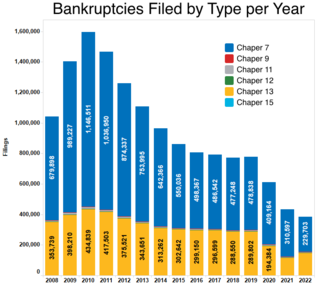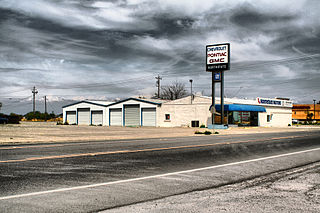Chapter 11 of the United States Bankruptcy Code permits reorganization under the bankruptcy laws of the United States. Such reorganization, known as Chapter 11 bankruptcy, is available to every business, whether organized as a corporation, partnership or sole proprietorship, and to individuals, although it is most prominently used by corporate entities. In contrast, Chapter 7 governs the process of a liquidation bankruptcy, though liquidation may also occur under Chapter 11; while Chapter 13 provides a reorganization process for the majority of private individuals.

Hummer is a brand of pickups and SUVs first marketed in 1992 when AM General began selling a civilian version of the M998 Humvee. Although discontinued in 2010, Hummer returned as a model under GMC in 2020. In 1998, General Motors (GM) purchased the brand name from AM General and marketed three vehicles: the original Hummer H1, based on the military Humvee, as well as the new H2 and H3 models that were based on smaller, civilian-market GM platforms.

The Saturn Corporation, also known as Saturn LLC, was an American automobile manufacturer, a registered trademark established on January 7, 1985, as a subsidiary of General Motors. The company was an attempt by GM to compete directly with Japanese imports and transplants, initially in the US compact car market. The company was known for its 'no-haggle' sales technique.
Midway Games Inc., known previously as Midway Manufacturing and Bally Midway, and commonly known as simply Midway, was an American video game developer and publisher. Midway's franchises included Mortal Kombat, Rampage, Spy Hunter, NBA Jam, Cruis'n, and NFL Blitz. Midway also acquired the rights to video games that were originally developed by Williams Electronics and Atari Games, such as Defender, Joust, Robotron: 2084, Gauntlet, and the Rush series.

Saab Automobile AB was a car manufacturer that was founded in Sweden in 1945 when its parent company, Saab AB, began a project to design a small automobile. The first production model, the Saab 92, was launched in 1949. In 1968 the parent company merged with Scania-Vabis, and ten years later the Saab 900 was launched, in time becoming Saab's best-selling model. In the mid-1980s the new Saab 9000 model also appeared.

In the United States, bankruptcy is largely governed by federal law, commonly referred to as the "Bankruptcy Code" ("Code"). The United States Constitution authorizes Congress to enact "uniform Laws on the subject of Bankruptcies throughout the United States". Congress has exercised this authority several times since 1801, including through adoption of the Bankruptcy Reform Act of 1978, as amended, codified in Title 11 of the United States Code and the Bankruptcy Abuse Prevention and Consumer Protection Act of 2005 (BAPCPA).

Spyker Cars is a Dutch sports car marque held by the holding company Spyker N.V.. The modern Spyker Cars held the legal rights to the brand name. The company's motto is "Nulla tenaci invia est via", Latin for "For the tenacious, no road is impassable". The marque's logo displays an aircraft propeller superimposed over a spoked wheel, a reference to the historic Spyker company that manufactured automobiles and aircraft. In 2010, the company acquired Swedish car manufacturer Saab Automobile from General Motors.

General Motors Europe was the European subsidiary of the American automaker General Motors ("GM"). The subsidiary was established by GM in 1986 and operated 14 production and assembly facilities in 9 countries, and employed around 54,500 people. GM's core European brands were Vauxhall and Opel, which both sell much the same range of cars in different markets. GM also owned the Swedish brand Saab until early 2010 and sold Chevrolet models between 2005 and 2015. The U.S. brand Cadillac is imported into Europe in small quantities. In 2009, General Motors (GM) announced to move its European headquarters from Zürich, Switzerland to Rüsselsheim, Germany to strengthen its German subsidiary Opel.

Jerome Bailey York, commonly known as Jerry York, was an American businessman, and the chairman, president and CEO of Harwinton Capital. He was the former CFO of IBM and Chrysler, and was CEO of Micro Warehouse. He was a chief aide to Kirk Kerkorian and his Tracinda investment company. In February 2006, Kerkorian helped elect York to the board of directors of General Motors, from which he had previously resigned.
A general assignment or assignment is a concept in bankruptcy law in which an insolvent entity's assets are assigned to someone as an alternative to a bankruptcy. One form is an "assignment for the benefit of creditors", abbreviated ABC or AFBC.

Victor Roberto Muller is a Dutch businessman, founder of Spyker Cars, CEO of Spyker N.V., and former Chairman and CEO of Saab Automobile AB.

Beginning in the latter half of 2008, a global-scale recession adversely affected the economy of the United States. A combination of several years of declining automobile sales and scarce availability of credit led to a more widespread crisis in the United States auto industry in the years of 2008 and 2009.
Chrysler LLC and 24 of its affiliated subsidiaries filed a consolidated petition for bankruptcy on April 30, 2009, with the federal bankruptcy court in New York. The court filing occurred upon failure of the company to come to an agreement with its creditors for an outside-of-bankruptcy restructuring plan, by the April 30 deadline mandated by the federal government.
The 2009 General Motors Chapter 11 sale of the assets of automobile manufacturer General Motors and some of its subsidiaries was implemented through Chapter 11, Title 11, United States Code in the United States bankruptcy court for the Southern District of New York. The United States government-endorsed sale enabled the NGMCO Inc. to purchase the continuing operational assets of the old GM. Normal operations, including employee compensation, warranties, and other customer services were uninterrupted during the bankruptcy proceedings. Operations outside of the United States were not included in the court filing.
Indiana State Police Pension Trust v. Chrysler LLC was a lawsuit brought in United States federal court June 2009 by several pension funds against Chrysler LLC and the United States Department of the Treasury, to block the planned sale of Chrysler LLC assets to a "New Chrysler" entity in the Chrysler bankruptcy.
Chevrolet-Saturn of Harlem, Inc., was a car dealership in the East Harlem neighborhood in New York City. Originally touted as a minority-owned dealership and part of the only new-car facility in Harlem, it was abandoned by its original operator within months and was taken over by General Motors directly. On June 1, 2009, it was used as the lead company in the General Motors Chapter 11 reorganization filing in New York.
Pre-packaged insolvency is a kind of bankruptcy procedure, where a restructuring plan is agreed upon in advance of a company declaring its insolvency. In the United States pre-packs are often used in a Chapter 11 filing. In the United Kingdom, pre-packs have become popular since the Enterprise Act 2002, which has made administration the dominant insolvency procedure. Such arrangements are also available in Canada under the Companies' Creditors Arrangements Act.

Youngman was a Chinese manufacturer of buses and trucks located in Jinhua, Zhejiang province. The company was founded in 2001 by Pang Qingnian and also used to manufacture automobiles. However, its passenger car business appears to have ceased operation by mid-2015.

The RACER Trust was created in March 2011 by a consent decree in the United States Bankruptcy Court for the Southern District of New York to clean up and position for redevelopment certain real properties owned by the former General Motors Corporation (“GMC”) and various GMC affiliates at the time of GMC's bankruptcy in 2009.
Saab Automobile was sold to Spyker Cars N.V. in 2010 after a deal between Spyker and then-current owner General Motors. After struggling to avoid insolvency throughout 2011, the company petitioned for bankruptcy following the failure of a Chinese consortium to complete a purchase of the company; the purchase had been blocked by former owner GM, which opposed the transfer of technology and production rights to a Chinese company. In 2012, Spyker filed a lawsuit against GM asking for US$3 billion in damages after GM had attempted to block the deals between Spyker and Chinese automaker Youngman, who were investing in Saab Automobile. Consequently, Saab was forced to file bankruptcy in 2012. Spyker's claim was dismissed in June 2013.













